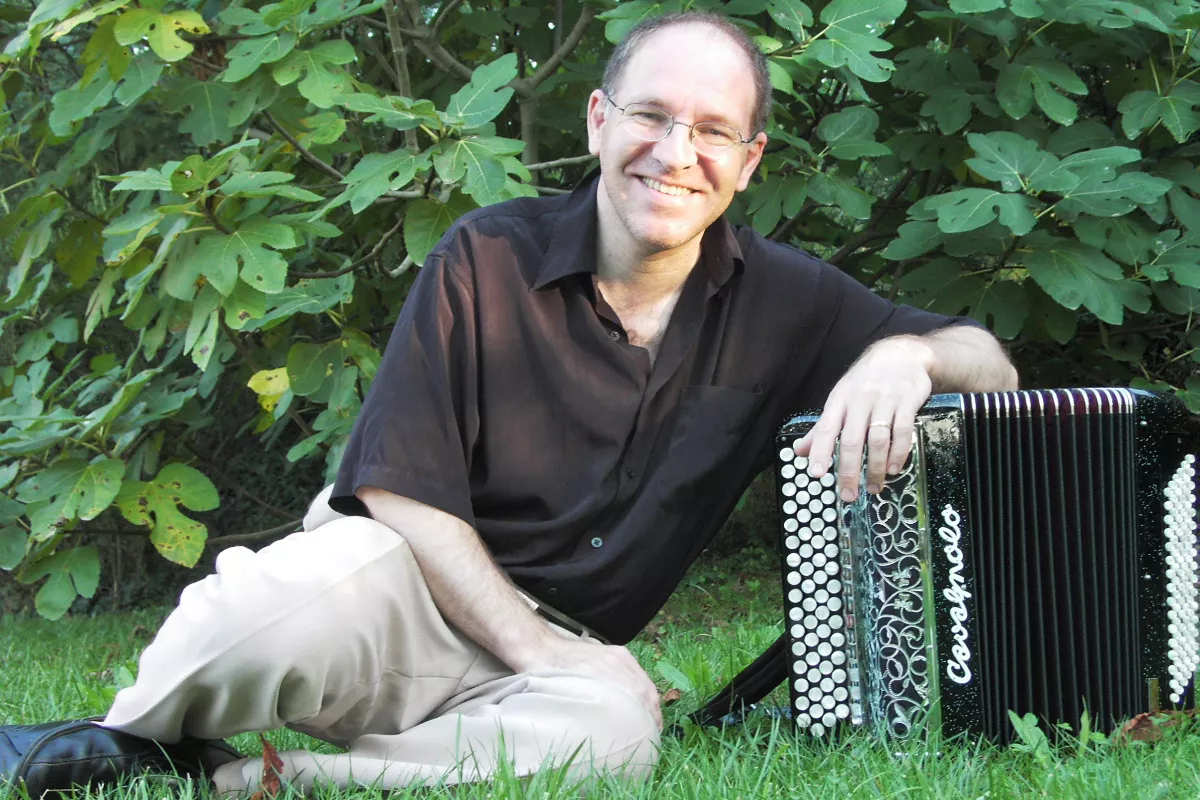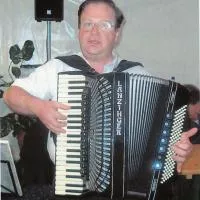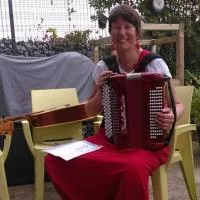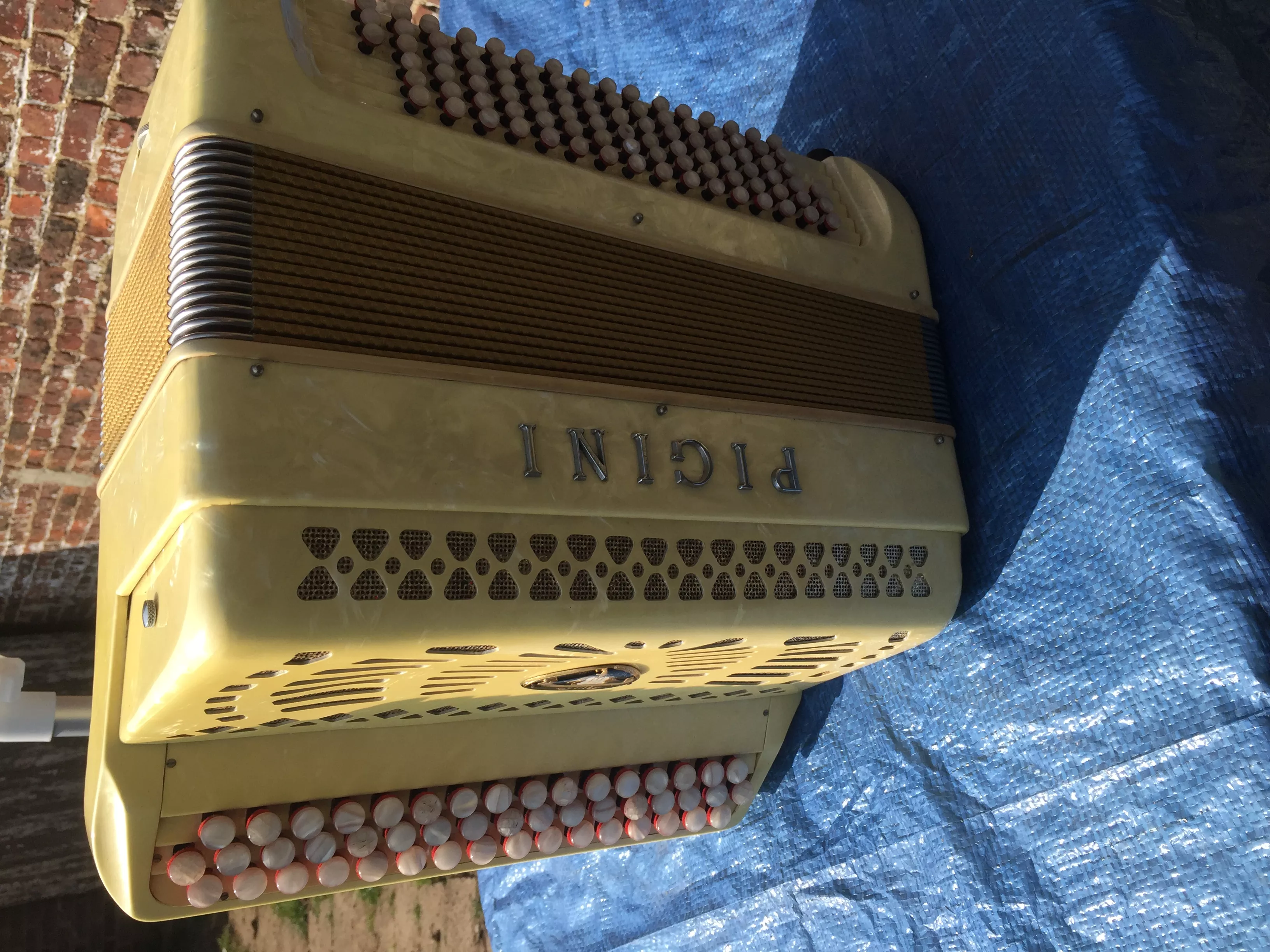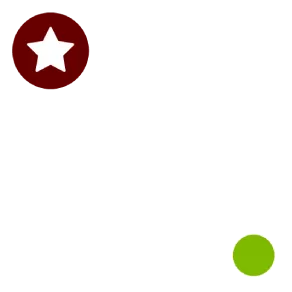BARCY
11/05/2025
Hello fogdoki77, if you're looking for this mazurka by Jo Privat, then I've just posted a handwritten version complete with variations. follow the link below. Yours faithfully Barcy
https://www.partitions-accordeon.com/partition/84336/L%27acrobate
https://www.partitions-accordeon.com/partition/84336/L%27acrobate
fogdoki77
12/05/2025
Bonjour cher Barcy,merci beaucoup!!!
Hello
I don't understand how the 3rd and 4th bars are played with the left hand in the mysterious piece by Jo Privat.
For the moment I play the bass A# with F#7 chord then C# with F# chord.
I also have a problem on the 7th bar because there is an eighth note rise in the left hand with a triplet in the right hand. Should I do 3 for 2 or am I cheating?
I don't understand how the 3rd and 4th bars are played with the left hand in the mysterious piece by Jo Privat.
For the moment I play the bass A# with F#7 chord then C# with F# chord.
I also have a problem on the 7th bar because there is an eighth note rise in the left hand with a triplet in the right hand. Should I do 3 for 2 or am I cheating?
1
Reply
melody20
17/09/2022
Mozart also did this in some pieces. A piece of advice: don't think about it and it will happen by itself.
Hello dear accordionist friends!
I am currently studying "Fantaisie Musette" a waltz by Jo Privat & André Verchuren. At bars 7 - 15 -26 is indicated an A7# dim. from C# on which chord should I go? I have a 120 bass accordion not equipped with the dim row. Thanks in advance for your help. ♪♫♪
I am currently studying "Fantaisie Musette" a waltz by Jo Privat & André Verchuren. At bars 7 - 15 -26 is indicated an A7# dim. from C# on which chord should I go? I have a 120 bass accordion not equipped with the dim row. Thanks in advance for your help. ♪♫♪
6
Replies
Dragonfly1954
28/03/2022
Hello, if I understand correctly, an A# is a Bb. For the 'dim' tuning, a 120 bass accordion would have 6 columns of buttons and the column furthest from the bellows should be the one of the diminished chords? This last one is '7thdim' without the fifth???
BIETRY
29/03/2022
hello, on accordions that have 3 rows of chords the last row on the outside of the body is in fact a diminished fifth. This allows you to play diminished chords. I won't go into the details of the harmony. So to make a diminished chord you just have to play the 7th chord which are one row down. Example to make a diminished C play the F7. For your request of the diminished A sharp (which is equal to Bb) play a button lower or Eb 7th. Or if it is too far for your score any note of the same vertical rank as the Eb, i.e. C7, Eb7, F sharp7 or A7. My explanation is of course only valid on accordions with 3 rows of chords. If you have any other questions, please do not hesitate to contact me. Jean-Yves Sixt from Switzerland
pinpin
17/04/2022
You can also add a Lab7 to the F7 It sounds even more "diminished".
Enki54
19/04/2022
thank you I will try and see ♪♫♪ regards
jphf51
06/06/2022
A#7dim = Bb7dim or the notes (harmonically) C#-e-G-sib = buttons together of A7 + C7 or A7 + F#7 depending on the sequences you have to do
Enki54
08/06/2022
Thank you so much, have a great day ♪♫♪ ♥
Hello to all, I discovered the site a little more than a year ago, but I had omitted to introduce myself... I started the chromatic accordion a year and a half ago, probably to find the timbre of my first instrument (a harmonica) and to be able to play Amélie's Waltz whenever I want :-).My favorite artists of the moment are- Jean Corti: I love his phrasing and his interpretations which change from bass-tune-tune, bass-tune-tune, bass-tune-...https://www.youtube.com/watch?v=Fkio7Pj3FZU- Marcel Loeffler: when I wonder if I chose the right instrument I watch this video:https://www.youtube.com/watch?v=0ey2Fic4QYU- Raul Barboza, whom I had the chance to meet in Parishttps://www.youtube.com/watch?v=1wFyY1w1bns- Marc Perrone: because diatonic is also goodhttps://www.youtube.com/watch?v=MJmTN1ZQz1s- Jo Privat: for the swing with finessehttps://www.youtube.com/watch?v=33rB-ResrSshttps://www.youtube.com/watch?v=t40stFq5V0o- Ludovic Beier: long live the improvisationhttps://www.youtube.com/watch?v=ypsZFR3GUKU- Serge Desaunay:https://www.youtube.com/watch?v=uYBIvv-SbIshttps://www.youtube.com/watch?v=HK80Gmly7H8- Dan Newton:https://www.youtube.com/watch?v=45rIoAirjTQ- Michel Macias: does anyone know what kind of bass he has on his left hand?https://www.youtube.com/watch?v=6qs68KxYdjE- Daniel Colin: so classy. A very soft play with the thumb, very dancing. https://www.youtube.com/watch?v=HhkPXxiSvFAhttps://www.youtube.com/watch?v=gNJ-go9BA78- Gianluigi Trovesi/Gianni Coscia: because he dares to compose for the accordion.
In any case, thank you for this collection of scores! Olivier
... and I discover them every day.
In any case, thank you for this collection of scores! Olivier
3
Replies
Khali
04/05/2017
Welcome and thanks for these videos....some musicians were totally unknown to me.
What do you mean by what kind of bass?
What do you mean by what kind of bass?
alexandrefred
05/05/2017
Welcome to you Olivier ;-)
for what seeks partitions of jo hubert who was as said jo privat "a laborious of the leaflet" you have the site:http://www.jo-hubert.fr/
0
Reply
Hello,
I put online a superb video of Jo Privat where he talks about the famous rue de Lappe, the cradle of the musette, noting his frankness and his anecdotes of a real Parisian: a delight.
Thanks to Camilla for pointing it out to me and with her permission.
Daniel
I put online a superb video of Jo Privat where he talks about the famous rue de Lappe, the cradle of the musette, noting his frankness and his anecdotes of a real Parisian: a delight.
Thanks to Camilla for pointing it out to me and with her permission.
Daniel
1
Reply
kouros
10/01/2015
Thank you Dan for this recording sometimes a little raw but that one listens with pleasure, one would almost believe in a film of the 30s so much it makes us live this Paris. I really liked the expression "le laborieux du dépliant" and there are many others!
kouros
kouros
HELLO MUSICIAN FRIENDS
Tony Muréna has recorded a lot, especially in his last period when, like many others, he devoted himself to the interpretation of variety songs or fashionable tunes. It was necessary to forget everything that recalled the war and therefore also the music of that period; in short, the swing era was over. We have privileged here this golden age of swing musette: that is to say the years 1939-1947, plus some later titles where Muréna still has beautiful accents. If many of these songs have already been re-released on CD, they were most often scattered on various compilations, most of the time mixed with typical or commercial songs, without any indication of date or personnel, and in these times where one product drives out the other, most of these discs are not available anymore (1). Here is for the first time in 3 CDs, and in chronological order, almost all of Tony Muréna's best tracks, (with precise references and indication of personnel when identified), showing his immense talent. THE BEGINNINGS Born in Italy in 1916, Antonio Muréna did not know his father, who died on the field of honor (fallen on the Chemin des Dames). Like many Italians, he arrived in France with his mother, who remarried in 1923 to a fellow countryman, shortly after the First World War. They settled in Nogent-sur-Marne and then in Joinville. An uncle gave his first accordion to the young Tony, who showed a serious aptitude for music and studied with passion and persistence. The autodidact benefits from the advice of the great Médard Ferrero. At the age of twelve, he already performed at his first balls. Then, launched by his cousin Louis Ferrari (1910-1988), also an accordionist, he started in cabarets and guinguettes. He lost his mother and then his stepfather and found himself alone with his sister and three half-sisters. To make boil the pot he puts the double bites, puts himself in the bandoneon and quickly integrates the best orchestras of tango (Rafael Canaro, Eduardo Bianco...). We are in 1932, Muréna is only 16 years old ! His quintet is sufficiently famous to be part of the replacements of the holder of the Balajo. Having to go on tour, Muréna proposes to Jo Privat to replace him at the Balajo; the latter will remain there 50 years! Muréna plays at La Silhouette, La Boule noire, La Java, Le Pré Catelan, Ciro's... The guitarists Didi Duprat, Lucien Gallopin, one or the other of the Ferré, are then its accompanists. SWING MUSETTE It is in France that the first full-fledged jazz accordion develops. Roger Etlens is said to have been one of the first to play jazz on the accordion, followed by Louis Richardet and Charley Bazin. But these precursors did not record much and it is Viseur who will be the first great jazz accordionist, followed immediately by Muréna. In the absence of the American models, who left for the United States after the declaration of war, the pioneers of the French swing accordion developed a style mixing American jazz, French musette and gypsy swing. Viseur, Muréna, and then Jo Privat, renovated the musette genre in depth by eliminating the accordion's vibrating register, introducing more sophisticated harmonies, and embarking on the adventure of what is called im-provisation. According to Mrs. Muréna's testimony (2), whenever they had a moment, Gus (Viseur) and Tony (Muréna) would play together just for them. We have a glimpse of what this could give, with about ten titles recorded around 1948 by the two companions (Matelo Ferret would be on guitar and the double bass player is not identified). These recordings, not very well known, were released under the name of Accordion's Club (cf. here "?Home Trainer?", the magnificent version of "?Body and Soul?", the super acceleration of tempo on "?On The Sunny Side of The Street?" which swings to death, and "?After You've Gone?) They will also play with the whole team of the Hot Club de France, where Muréna joins in 1941, and meet in boeufs, after the concerts, and more regularly thereafter at the Mirliton, a dance hall that Muréna buys in 1949 on the side of the place Clichy, and where all the accordionists come, at least those who like the beautiful chords. Still according to Mrs Muréna, Django and Tony liked to play together... What a pity that no sound trace has reached us! "... We were in Les Sables d'Olonne when Tony learned that Django had died. Tony collapsed. That's the only time I saw my husband cry..." (3) MURÉNA, VEDETTE DES DISQUES ODÉON In 1939, shortly before the declaration of war, Tony met Emile Prud'homme (who was to become his brother-in-law), who had just recorded for the prestigious Odéon record label. He introduced Tony to the artistic director of the label, Edouard Dory, who was truly enthusiastic about his sparkling playing. On May 11, 1939, two swings are recorded, "?Madam's?" co-composed by Muréna with P. Fontaine and "?all is not lost?", a light swing by Louis Richardet. Jacques Petitsigne is on double bass, Matelo and Sarane on guitars, the latter illustrating himself by two remarkably constructed choruses and of course Tony on accordion, who combines in his phrasing beautiful and elegant. From the beginning of the 1940s, Muréna gave a new dimension to the accordion, surrounding himself with the best jazz musicians of the time: the drummers Georges Marion, Jacques Irsa, Roger Paraboschi, Pierre Fouad, the double bassists Jean Merlin, Jacques Petitsigne, René Larguier or Pascal Groffe, the clarinettists Pierre Gossez, Francis Camus, Lucas, Pierre Delhoumeau or Hubert Rostaing, the pianists Michel Ramos or Boris Sarbek, the guitarists Didi Duprat, René Duchaussoir, Lucien Gallopin... Between 1939 and 1943, Muréna drew largely from the gypsy source and more exactly from the gypsy source, by joining, just like Viseur (and a little later Privat) the talents of the Ferret brothers: Baro, Matelo and Sarane. In 1941, Tony becomes the star of the Odeon records and puts 22 titles in the can that year; the accordionist has perhaps never played so brilliantly. If his style is less fiery, less flamboyant than Viseur's, his touch is more sentimental and airy (cf. "?Le paradis perdu?", a magnificent ballad where Muréna combines finesse and feeling, this beautiful version of "?Yeux noirs?" with a long guitar chorus probably by Sarane, or these nervous swings like "?Le jitterbug?", "?Playmates?", "?Express 113?"or "China Town", an "American" jazz theme that the needs of the French production will rename "Chinatown", the opportunity for Muréna to launch some beautiful rockets), these last titles almost all interpreted with a septet with a very Goodmanian spirit: piano, drums and clarinet (excellent chorus of Pierre Delhoumeau). The accordionist treats the instrument like a real orchestra, taking advantage of all its resources: finesse of play, phrasing of a rare elegance, sense of exposition of a theme, constant inspiration. Stylist as there are few, he is never in the clichés: originality, spirit of creation and freshness are at the appointment. For Marcel Azzola, "?when Tony plays, we forget that it is the accordion, he is an authentic genius? Muréna is also the author of some fabulous compositions such as "Swing promenade", "Pacific" (a kind of blues that starts a bit like Django Reinhardt's "Rythm Futur", with an acceleration of the tempo illuminated by a sparkling guitar chorus, probably due to Baro Ferret, and rockets sent by Tony), "Ciro's", on which his suppleness and relaxed phrasing are marvellous, "Milk Bar", one of his most famous swings."one of his most accomplished swings or "?Pré catelan?", a swing recorded on May 30, 1942, a day when grace was undoubtedly upon him, since he also recorded "?Indifference? and "?Passion?", two masterpieces of great melodic beauty, co-composed with Joseph Colombo, charged with sensitivity and emotion, illuminated by Baro's chorus and which have not ceased to be played and replayed since. Muréna is thus, with Viseur and Privat, the singer of the waltz in minor which, imbued with a certain spleen, imposes itself as the masterpiece of jazz musette. MYSTERY AND GUMDROP !
Tony Muréna has recorded a lot, especially in his last period when, like many others, he devoted himself to the interpretation of variety songs or fashionable tunes. It was necessary to forget everything that recalled the war and therefore also the music of that period; in short, the swing era was over. We have privileged here this golden age of swing musette: that is to say the years 1939-1947, plus some later titles where Muréna still has beautiful accents. If many of these songs have already been re-released on CD, they were most often scattered on various compilations, most of the time mixed with typical or commercial songs, without any indication of date or personnel, and in these times where one product drives out the other, most of these discs are not available anymore (1). Here is for the first time in 3 CDs, and in chronological order, almost all of Tony Muréna's best tracks, (with precise references and indication of personnel when identified), showing his immense talent. THE BEGINNINGS Born in Italy in 1916, Antonio Muréna did not know his father, who died on the field of honor (fallen on the Chemin des Dames). Like many Italians, he arrived in France with his mother, who remarried in 1923 to a fellow countryman, shortly after the First World War. They settled in Nogent-sur-Marne and then in Joinville. An uncle gave his first accordion to the young Tony, who showed a serious aptitude for music and studied with passion and persistence. The autodidact benefits from the advice of the great Médard Ferrero. At the age of twelve, he already performed at his first balls. Then, launched by his cousin Louis Ferrari (1910-1988), also an accordionist, he started in cabarets and guinguettes. He lost his mother and then his stepfather and found himself alone with his sister and three half-sisters. To make boil the pot he puts the double bites, puts himself in the bandoneon and quickly integrates the best orchestras of tango (Rafael Canaro, Eduardo Bianco...). We are in 1932, Muréna is only 16 years old ! His quintet is sufficiently famous to be part of the replacements of the holder of the Balajo. Having to go on tour, Muréna proposes to Jo Privat to replace him at the Balajo; the latter will remain there 50 years! Muréna plays at La Silhouette, La Boule noire, La Java, Le Pré Catelan, Ciro's... The guitarists Didi Duprat, Lucien Gallopin, one or the other of the Ferré, are then its accompanists. SWING MUSETTE It is in France that the first full-fledged jazz accordion develops. Roger Etlens is said to have been one of the first to play jazz on the accordion, followed by Louis Richardet and Charley Bazin. But these precursors did not record much and it is Viseur who will be the first great jazz accordionist, followed immediately by Muréna. In the absence of the American models, who left for the United States after the declaration of war, the pioneers of the French swing accordion developed a style mixing American jazz, French musette and gypsy swing. Viseur, Muréna, and then Jo Privat, renovated the musette genre in depth by eliminating the accordion's vibrating register, introducing more sophisticated harmonies, and embarking on the adventure of what is called im-provisation. According to Mrs. Muréna's testimony (2), whenever they had a moment, Gus (Viseur) and Tony (Muréna) would play together just for them. We have a glimpse of what this could give, with about ten titles recorded around 1948 by the two companions (Matelo Ferret would be on guitar and the double bass player is not identified). These recordings, not very well known, were released under the name of Accordion's Club (cf. here "?Home Trainer?", the magnificent version of "?Body and Soul?", the super acceleration of tempo on "?On The Sunny Side of The Street?" which swings to death, and "?After You've Gone?) They will also play with the whole team of the Hot Club de France, where Muréna joins in 1941, and meet in boeufs, after the concerts, and more regularly thereafter at the Mirliton, a dance hall that Muréna buys in 1949 on the side of the place Clichy, and where all the accordionists come, at least those who like the beautiful chords. Still according to Mrs Muréna, Django and Tony liked to play together... What a pity that no sound trace has reached us! "... We were in Les Sables d'Olonne when Tony learned that Django had died. Tony collapsed. That's the only time I saw my husband cry..." (3) MURÉNA, VEDETTE DES DISQUES ODÉON In 1939, shortly before the declaration of war, Tony met Emile Prud'homme (who was to become his brother-in-law), who had just recorded for the prestigious Odéon record label. He introduced Tony to the artistic director of the label, Edouard Dory, who was truly enthusiastic about his sparkling playing. On May 11, 1939, two swings are recorded, "?Madam's?" co-composed by Muréna with P. Fontaine and "?all is not lost?", a light swing by Louis Richardet. Jacques Petitsigne is on double bass, Matelo and Sarane on guitars, the latter illustrating himself by two remarkably constructed choruses and of course Tony on accordion, who combines in his phrasing beautiful and elegant. From the beginning of the 1940s, Muréna gave a new dimension to the accordion, surrounding himself with the best jazz musicians of the time: the drummers Georges Marion, Jacques Irsa, Roger Paraboschi, Pierre Fouad, the double bassists Jean Merlin, Jacques Petitsigne, René Larguier or Pascal Groffe, the clarinettists Pierre Gossez, Francis Camus, Lucas, Pierre Delhoumeau or Hubert Rostaing, the pianists Michel Ramos or Boris Sarbek, the guitarists Didi Duprat, René Duchaussoir, Lucien Gallopin... Between 1939 and 1943, Muréna drew largely from the gypsy source and more exactly from the gypsy source, by joining, just like Viseur (and a little later Privat) the talents of the Ferret brothers: Baro, Matelo and Sarane. In 1941, Tony becomes the star of the Odeon records and puts 22 titles in the can that year; the accordionist has perhaps never played so brilliantly. If his style is less fiery, less flamboyant than Viseur's, his touch is more sentimental and airy (cf. "?Le paradis perdu?", a magnificent ballad where Muréna combines finesse and feeling, this beautiful version of "?Yeux noirs?" with a long guitar chorus probably by Sarane, or these nervous swings like "?Le jitterbug?", "?Playmates?", "?Express 113?"or "China Town", an "American" jazz theme that the needs of the French production will rename "Chinatown", the opportunity for Muréna to launch some beautiful rockets), these last titles almost all interpreted with a septet with a very Goodmanian spirit: piano, drums and clarinet (excellent chorus of Pierre Delhoumeau). The accordionist treats the instrument like a real orchestra, taking advantage of all its resources: finesse of play, phrasing of a rare elegance, sense of exposition of a theme, constant inspiration. Stylist as there are few, he is never in the clichés: originality, spirit of creation and freshness are at the appointment. For Marcel Azzola, "?when Tony plays, we forget that it is the accordion, he is an authentic genius? Muréna is also the author of some fabulous compositions such as "Swing promenade", "Pacific" (a kind of blues that starts a bit like Django Reinhardt's "Rythm Futur", with an acceleration of the tempo illuminated by a sparkling guitar chorus, probably due to Baro Ferret, and rockets sent by Tony), "Ciro's", on which his suppleness and relaxed phrasing are marvellous, "Milk Bar", one of his most famous swings."one of his most accomplished swings or "?Pré catelan?", a swing recorded on May 30, 1942, a day when grace was undoubtedly upon him, since he also recorded "?Indifference? and "?Passion?", two masterpieces of great melodic beauty, co-composed with Joseph Colombo, charged with sensitivity and emotion, illuminated by Baro's chorus and which have not ceased to be played and replayed since. Muréna is thus, with Viseur and Privat, the singer of the waltz in minor which, imbued with a certain spleen, imposes itself as the masterpiece of jazz musette. MYSTERY AND GUMDROP !
0
Reply
pontiac
24/06/2013
Hi Dan,
it is on the site heading Jo Privat has page 6, the title "Dia Chroma".
http://www.partitions-accordeon.com/partitions/categorie=all/artiste=Jo%20Privat/s=Rechercher/page=5
Very good choice!
Friendly
it is on the site heading Jo Privat has page 6, the title "Dia Chroma".
http://www.partitions-accordeon.com/partitions/categorie=all/artiste=Jo%20Privat/s=Rechercher/page=5
Very good choice!
Friendly
dan95
24/06/2013
Hello Pontiac,
Unfortunately it's not this one, I also confused them because they look the same.
Thank you for your involvement.
Good day to you.
Dan
Unfortunately it's not this one, I also confused them because they look the same.
Thank you for your involvement.
Good day to you.
Dan
pontiac
24/06/2013
Sorry Dan,
there is a little resemblance with the niglo waltz too. I hope that a member has this score, I will be a customer too.
Very good Jo Privat
Friendly
there is a little resemblance with the niglo waltz too. I hope that a member has this score, I will be a customer too.
Very good Jo Privat
Friendly
dan95
24/06/2013
Thanks to cindou for his research, the vise is tightening.
n n n n n n n n n n n n n n n n n n n n n
n n n n n n n n n n n n n n n n n n n n n n n n n n n n n n n n n n Composer : GEORGES PRI
n n n n n Publisher : INTER LOISIRS DISC
n n n n n n n n ISWC : T-003.344.035.5
n n n n n n n n n n n n n n n n n n n n n
n n n n n n n n n n n n n n n n n n n n n n n n n n n n n n n n n n Composer : GEORGES PRI
n n n n n Publisher : INTER LOISIRS DISC
n n n n n n n n ISWC : T-003.344.035.5
pontiac
24/06/2013
Hello cindou and thanks for the title.
Sacre Jo, there must be still some nice tunes like this one that are hard to find.
The song is not too hard so keep your ears open...
Thanks to both of you,
friendly
Sacre Jo, there must be still some nice tunes like this one that are hard to find.
The song is not too hard so keep your ears open...
Thanks to both of you,
friendly
Unknown
27/03/2013
hello frerikthe report on the history and the origin of the musette is interesting and is very practical to explain to the youngest why so many people are sensitive to this style of music (too bad the images are too often blurred)the accordion is a young and complete instrument, it gives the desire to move and touches the feelings in all styles of music! thank you for the videoGerminon
Hello to all, Here is where our scores go, I don't have a certain one but I am convinced because I had transcripts made by my hand and not found like some of us.
http://www.caverne-partitions.com/t107294-liste-accordeon-par-compositeur-astier-azzola-baselli-viseur-galliano-privat-horner-lassagne-corchia
http://www.caverne-partitions.com/t107294-liste-accordeon-par-compositeur-astier-azzola-baselli-viseur-galliano-privat-horner-lassagne-corchia
0
Reply























